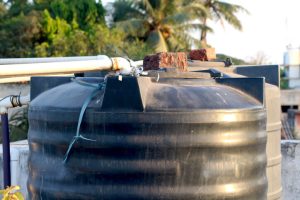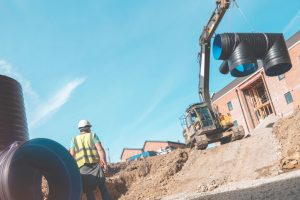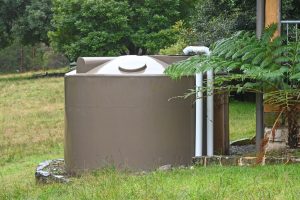Home » Stormwater & Rainwater
Changes in precipitation levels and increased non-porous surface area in high-density areas mean that more new builds are being required to provide a solution for stormwater to prevent aging storm sewers from overflowing. Whether it’s temporary storage so that water can be released outside of peak times or collection to use for irrigation, FRP can provide a perfect solution. We have a huge range of sizes in both below and above-ground stormwater tanks and we can even provide rainwater filtration systems as required.
The approach for controlling runoff water involves implementing strategies for infiltration, detention, and discharge. These methods allow for either collecting and preserving water for personal usage or temporarily storing it before releasing it following local regulations. Additional options encompass utilizing gutters and spillways, constructing swales, employing permeable pavements, or facilitating on-site discharge. The choice among these techniques depends on factors such as location, budget, and spatial limitations.
Stormwater detention tanks serve as reservoirs for water collected from natural sources such as rain or snow. These stormwater tanks are designed to temporarily hold stormwater, particularly during periods of heavy rainfall. Their design typically incorporates specially engineered valves that facilitate gradual release over time.
In urbanized areas, impermeable surfaces like pavement and rooftops prevent rainwater from naturally infiltrating the ground. Instead, runoff flows into drains, sewer systems, and drainage ditches, carrying with it various pollutants such as debris, chemicals, bacteria, and eroded soil. Rapid influxes of water can overwhelm underground infrastructure like conduits and sewer lines, resulting in flooding, erosion, and water turbidity.
Local regulations enforced by municipal authorities aim to prevent contaminated water from properties reaching nearby streams, rivers, lakes, and wetlands. As a result, many new construction projects, both commercial and residential, incorporate stormwater detention tanks into their parking lots, open spaces, and backyards. These detention and drainage systems effectively deal with accumulated water while complying with environmental regulations.
Each area receives a specific amount of rainfall. In rainwater retention or harvesting, we gather water before it touches the ground. This collected rainwater can be utilized for domestic, agricultural, and commercial purposes, as it typically contains fewer contaminants. To achieve this, a rainwater retention tank is necessary.
Stormwater, on the other hand, comes into contact with the ground and flows through gutters, pavements, and land areas, carrying soil, debris, contaminants, and other residues. Until undergoing several filtrations, this water doesn’t serve any practical purpose, making drainage the most sensible option.
Failure to drain manageable amounts of this water at regular intervals during heavy downpours can lead to flooding. In such instances, a detention of stormwater tanks becomes essential.
A retention tank is suitable for harvesting rainwater rather than allowing it to drain away. Utilizing harvested rainwater can be beneficial for:
This type of reuse can be particularly advantageous for those in rural areas or with restricted access to the water supply.
As the name implies, detention tanks temporarily hold water and release it slowly over a specified period. Rapidly increasing a town’s existing drainage capacity in urban and suburban areas can be challenging.
Some builders offer a dual retention/detention system installation. This design is beneficial for individuals in areas prone to heavy downpours, as retention tanks quickly accumulate water during such weather and release it when necessary.
Stormwater tanks are available in various shapes, sizes, and constructions. The most common materials used for constructing retention/detention water tanks include polyethylene, fiberglass, stainless, and galvanized steel.
Polyethylene is a popular choice due to its strength, durability, and relatively lightweight, making it widely used in the market. Additionally, high-quality plastic is recyclable and reusable, contributing to its eco-friendliness. Poly tanks are straightforward to install and offer cost-effective solutions.
Fiberglass is a lightweight composite material made of glass fibers reinforced into plastics. While it’s rigid and light, its thin cross-section can make it susceptible to cracking. The quality of fiberglass varies depending on the manufacturing process and parameters.
Stainless steel tanks are versatile and durable, offering a combination of aesthetic appeal and corrosion resistance. They maintain their properties at various temperatures, making them suitable for collecting water from snow and rain in cold and humid regions.
Galvanized steel, coated with a layer of zinc, protects against corrosion. However, damage to the zinc layer can accelerate rusting. Zinc, being softer than steel, is prone to wear and tear. Some manufacturers use polyethylene liners to shield the zinc coating from leaks and prevent rusting.
Another alternative for managing rain and snow water is to construct an underground stormwater collection system. Underground water tanks are particularly useful in densely populated urban areas with limited space.
Effective stormwater management is essential for residential, commercial, and industrial properties alike. Choosing the right stormwater detention tank enables responsible handling of precipitation on your premises, mitigating the hazards associated with runoff.
FRP Mocoat Fiberglass stands as a premier supplier of storage solutions, offering assistance to customers in meeting environmental compliance standards. Our tanks adhere to rigorous regulations for environmental remediation endeavors, delivering both efficacy and cost-efficiency.
You can order stormwater tanks in Canada (Saskatchewan, Alberta, Manitoba, and other cities) at an affordable price by dialing: (306) 329-4884.



FRP Mocoat Fiberglass Ltd. © 2024
FRP Mocoat Fiberglass Ltd. © 2024